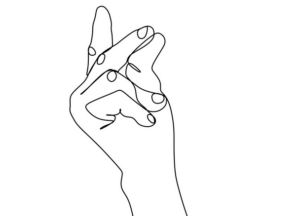Finger drawing for beginners introduces a tactile approach, unlocking creativity through simple strokes, and encouraging artistic exploration with minimal tools. Finger drawing is an engaging and accessible technique that transcends the boundaries of traditional art tools. In this guide, we’ll explore the fundamentals of finger drawing, innovative techniques, and how beginners can unleash their creativity through this hands-on approach.

Understanding Finger Drawing
Finger drawing is a form of tactile art that involves using your fingers as the primary tool for creating visual masterpieces. Unlike traditional drawing tools, your fingers offer a direct connection between your emotions and the canvas, making the artistic process more intimate and immediate.
To begin, gather your art supplies – quality paper, vibrant finger paints, and a willingness to let your creativity flow. Finger drawing is not just about precision; it’s about expressing yourself through the strokes and swirls of your fingertips.
Techniques to Elevate Your Finger Drawing Skills
- Blending Brilliance: Use your fingers to blend colours seamlessly. This technique allows for smooth transitions and gradients, adding depth and dimension to your artwork.
- Textured Touch: Experiment with different textures by varying the pressure and movement of your fingers. Create intricate patterns and tactile sensations within your artwork.
- The Power of Layers: Apply multiple layers of paint to build complexity. Let each layer dry before adding the next to avoid muddiness and achieve a visually captivating result.
- Precision Points: Your fingertips are versatile tools. Use the tip for fine details, and the sides for broader strokes. Mastering this balance adds nuance to your finger-drawn creations.
Finger Drawing Projects for Beginners
- Abstract Exploration: Embrace the freedom of abstraction. Let your fingers dance across the canvas, creating shapes, lines, and patterns that express your mood and emotions.
- Nature’s Palette: Use your fingertips to recreate the beauty of nature. Craft vibrant landscapes, textured flowers, and abstract representations of the world around you.
- Expressive Portraits: Channel your emotions into portraiture. Finger drawing allows for an expressive and personal touch, bringing life to your subjects in a way that’s uniquely yours.
Tips for Finger Drawing Success
- Patience is Key: Allow layers to dry between applications to prevent smudging and achieve crisp details.
- Experiment with Pressure: Varying pressure produces different effects. Play with light touches and bold strokes to discover your preferred style.
- Embrace Imperfections: Finger drawing is organic and spontaneous. Embrace imperfections as part of the charm in your artwork.
Finger Drawing Projects for Every Mood
Abstract Exploration
Embark on a journey of free expression with abstract finger drawing. Let your emotions guide your fingers as they dance across the canvas, forming spontaneous shapes, lines, and patterns. Abstract finger drawing is a therapeutic exercise, allowing you to release emotions onto the canvas without the constraints of realism.
Nature’s Palette
Bring the beauty of the outdoors to life with nature-inspired finger drawings. Craft vibrant landscapes, textured flowers, or abstract representations of the natural world. Use your fingers to mimic the organic shapes and textures found in nature, creating visually stunning and emotionally resonant artwork.
Expressive Portraits
Challenge yourself with finger-drawn portraits that capture the essence of your subjects. The tactile connection between your fingers and the canvas allows for a personal and expressive touch. Infuse emotion into your portraits, conveying the subtleties of the human experience through the strokes of your fingertips.
Fine-Tuning Your Finger Drawing Skills
- Patience is Key: Allow layers to dry thoroughly between applications to prevent unintentional smudging. This patience ensures that each detail remains crisp and distinct in your finger drawings.
- Experiment with Pressure: Varying the pressure of your finger strokes produces different effects. Practice light touches for delicate details and apply more pressure for bold, expressive strokes. This experimentation allows you to discover your unique style.
- Embrace Imperfections: Finger drawing is inherently organic and spontaneous. Embrace imperfections as part of the charm in your artwork. These quirks contribute to the authenticity of your creations, making each piece uniquely yours.
Conclusion
Finger drawing for beginners is more than an artistic technique; it’s a journey of self-discovery. The tactile connection between your fingers and the canvas opens new possibilities for creativity. Embrace the freedom, explore techniques, and let your fingertips guide you on a unique artistic adventure. Whether you’re a seasoned artist or a novice, finger drawing offers a refreshing and accessible way to express your inner world on canvas. So, gather your paints, clear your mind, and let your fingers tell your story on the canvas of limitless possibilities.
